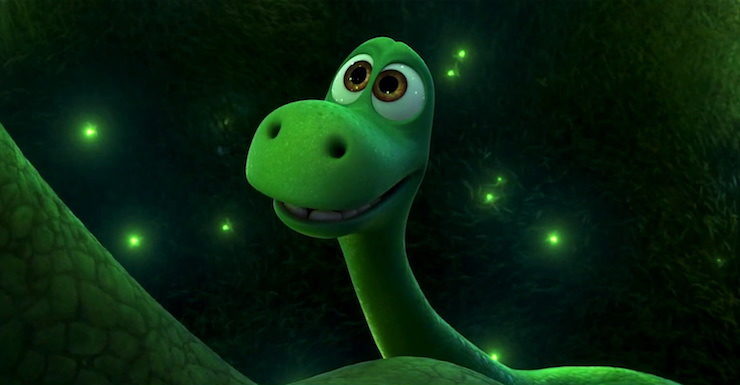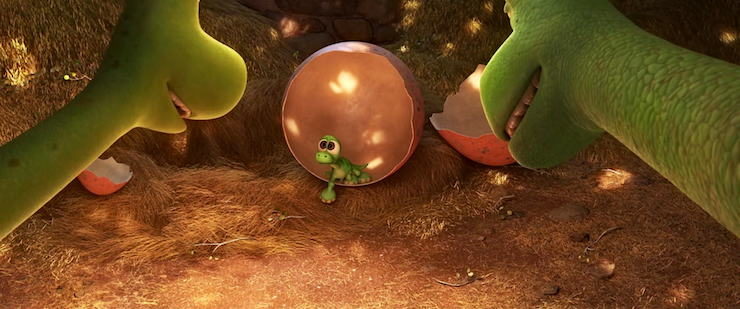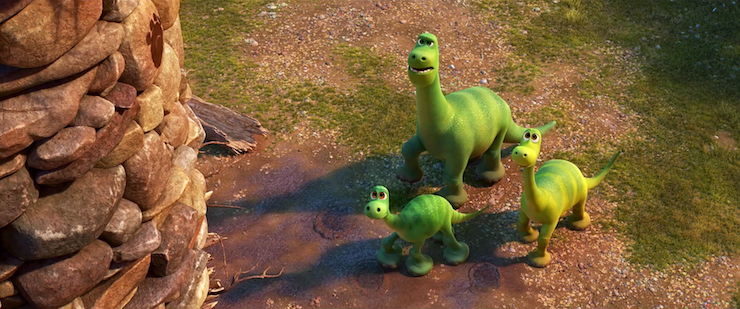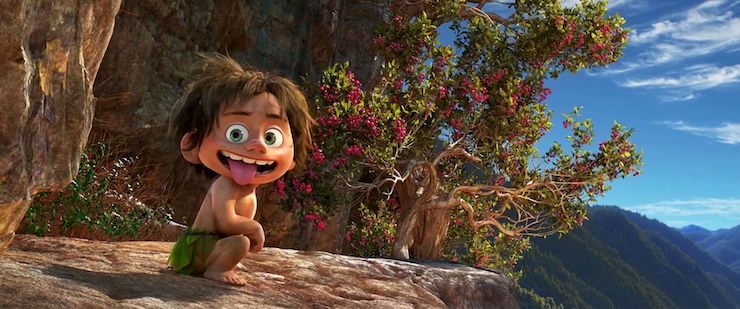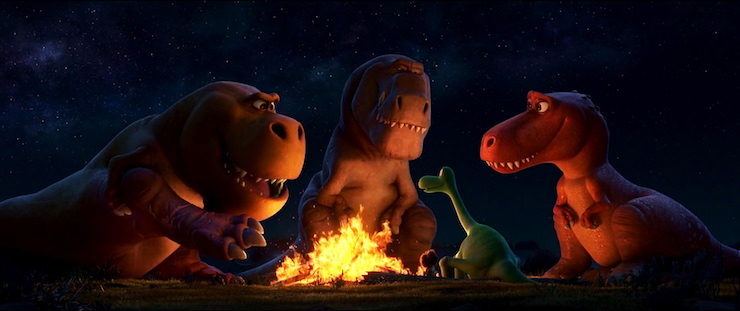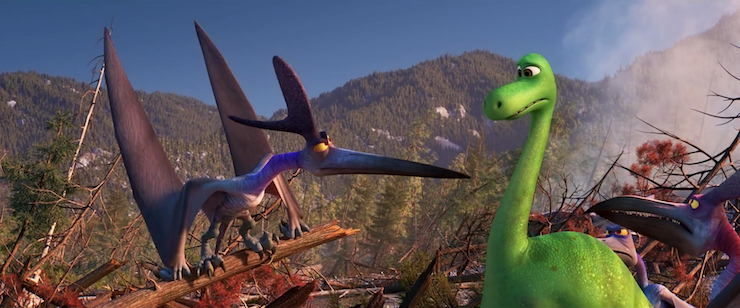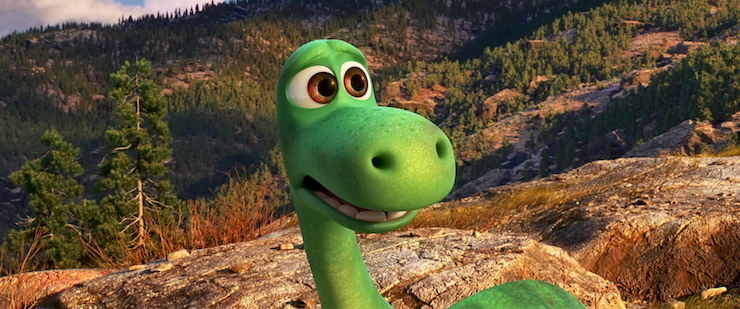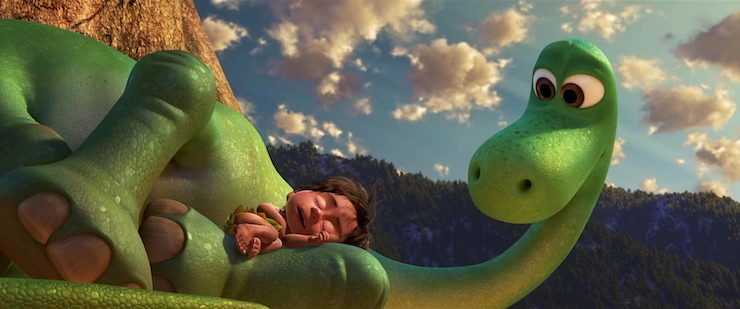Disney had never had much luck with animated dinosaurs. The dinosaurs of Fantasia had been one of the most critically panned parts of that otherwise astonishing film, and Fantasia itself needed several rereleases before it turned a profit. Dinosaur was a minor box office success, but a dull movie that earned little critical praise and was soon forgotten. (It didn’t help that it was not even recognized by Disney as a Disney animated film for a few years after its release.)
Still. Rival Universal Studios continued to have amazing success with films that focused on dinosaurs eating people, and the dinosaur attractions at Disney’s Animal Kingdom and even—to a lesser extent—the dinosaur attraction at Epcot remained popular with tourists.
If Disney couldn’t exactly make dinosaurs work—well. Perhaps Pixar could.
They could—but at least some of their artists really wanted to work, not with dinosaurs, but on a Western.
That disconnect between “Western” and “dinosaur,” not to mention the dinosaur cowboys, perhaps explains why, even by the standards of an animation studio by now renowned for troubled, stressful productions, The Good Dinosaur stands out as a troubled, stressful production. The film’s release date was pushed back not just once, but twice—giving a touch more breathing room to the later Finding Dory, though not the next two films, Cars 2 and Coco, both kept firmly on track to ensure that Pixar would not have to rush the final work on Incredibles 2. (As I type, reports are that Pixar had to rush the final work on Incredibles 2, but I anticipate.)
Writers changed; directors changed; producers changed; voice actors were cast and recast, with many of the original voice cast heading on to other projects. Various top Pixar creatives—including John Lasseter, at the time also supervising multiple Disney and DisneyToon projects—stepped in to help. Mid-production, several Pixar employees were laid off. The film wasn’t released until two full years after its deadline.
Pixar executive Jim Morris later tried to wave all of this off by saying that it was because “We wanted a great movie.” Fair enough, but it was hard not to notice that Pixar had released other great movies without experiencing quite this many problems.
What went wrong?
Well, as a start, some of the initial character concepts. The Good Dinosaur originally featured a very large dinosaur named Arlo. Large dinosaurs certainly fit into most people’s preconceptions about dinosaurs, but a large dinosaur surrounded by other large dinosaurs is not necessarily the most sympathetic figure—let alone a character small children could be expected to relate to. So Pixar tweaked the concept, turning Arlo into a small, comparatively weak dinosaur.
Vestiges of this remain in the final film, particularly in an early scene showing that dinosaurs can knock a tree down with just one swipe of a tail, a foreshadowing of a later moment where Arlo needs to knock a tree and has nothing to cut trees with other than his tail. Unfortunately, the shift in concept meant that Arlo was now, technically, too small to cut down trees with his tail—something the later scene elided by making it a slightly smaller tree and giving Arlo more of an emotional need to cut down the tree beyond “having some corn there would be nice.”
But the real problem was with the original concept, which could basically be summed up as “Cars, but with dinosaurs!” That is, an alternative Earth where the asteroid that wiped out the dinosaurs actually missed the Earth entirely, leaving dinosaurs in charge of the Earth, driving cars, making dinosaur pizza, and so on. This did lead to an impressive opening image of an asteroid belt that almost looks like a picture snapped from one of the recent Galileo or New Horizons missions, with only the “65 million years ago” tagline giving the game away. Oh, and if you look very carefully, an asteroid shaped like a pizza truck which astronomers have assured me is not typical of most asteroids in our solar system.
In another nice touch, the current continents are just slightly off as the asteroid hurls towards Earth—and if it’s not completely geologically accurate, well, this is an alternate Earth, so it would make sense for the protocontinents to be ever so slightly off. In a rather less nice touch, the asteroid swings just close enough that a number of dinosaurs just trying to eat a nice dinner notice it, which I would think might be close enough to get it dragged into Earth by Earth’s gravity, but we have a number of other scientific issues to get to so let’s leave this one.
Because—amazing opening sequences aside—the idea of “Cars, but with dinosaurs!” ran into an immediate problem: Cars is just not a very good movie, and redoing it with dinosaurs didn’t help. Oh, sure, it allowed for some entertaining jokes here and there, a few of which remain in the final film: the way large dinosaurs can use their noses as both plows and sprinklers, for instance—ha ha it’s funny because dinosaurs, get it—or a very weird moment with a Styracosaurus, voiced by Pixar animator and storyboard artist Peter Sohn that I suspect worked much better in the original concept. But a differently-populated world that mimicked our world had not only already been done with Cars and Monsters, Inc., but also simply didn’t work that well with dinosaurs.
Instead, as production started and stopped and writers came and went, The Good Dinosaur began shifting into a very different sort of film. Instead of a “hey, what if this was our world, but with dinosaurs!” the film would be the tale of a boy and his dog—or rather, a dinosaur and his little human, who acts remarkably like a dog—against nature, and all of the terrors within. But since this shift did not come until production was fairly far along, and that with three separate films scheduled for release in 2016 (Zootopia, Finding Dory, and Moana), production on The Good Dinosaur could not be delayed any further, the final film bristled with elements of both—to the film’s detriment.
It doesn’t help that the vestiges that remain from the earlier concept frequently don’t make a lot of sense. Why, for instance, are dinosaurs keeping chickens (or what are kinda chickens)—something that becomes even more disturbing later in the film when it turns out that Arlo can speak to all other dinosaurs in fluent English (apparently, some past Anglo-Saxon dinosaurs conquered the UK and then in turn were conquered by some nice Norman French dinosaurs, allowing English to develop and be brought over to the American Southwest, and no, I don’t know what happened to the Native American dinosaurs in this fanwank, work with me here) including dinosaurs of extremely different species, like Tyrannosaurus Rexes and Velociraptors (presumably included thanks to their prominence in the Jurassic Park franchise) and is even able to communicate with various cave people using drawings and sticks. And for that matter, how, exactly, have the dinosaurs managed to breed chickens and corn while remaining otherwise unchanged for 65 million years?
But back to the plot. Little Arlo, the smallest and most timid of three triplet dinosaurs, is determined to make his mark—that is, do something bigger than himself so he can put a pawprint up on the family tower with the rest of his family, like, ok, since Arlo is smaller to begin with, I suppose it should be easier to find something bigger than himself to do, but otherwise, forcing the clearly smaller and physically weaker kid to do something physically equivalent to his two siblings and parents seems a bit harsh, dino parents. Poppa Dinosaur decides that the best way to accomplish this is to have Arlo—who is scared of chickens—guard the family’s food source from a “critter” that keeps stealing from it. Said Critter turns out to be Spot, a small human who acts like a dog, ha ha ha. Arlo, quite possibly thinking of the upcoming merchandise opportunities, and the fact that he’s technically in a film aimed at kids, can’t quite bring himself to kill Spot, which then leads to a wild chase scene over a rugged mountain range as thunder and lightning and torrential rain pound down.
And in a scene somewhat reminiscent of Mustafa’s death in The Lion King, Poppa is swept away by the rushing river.
Arlo, however, does not run away, as Simba does. Nor does he take responsibility for his father’s death. Instead, he returns home, to face his mother’s guilt trips (seriously, dino parents?) and doubts that they will have enough food for the winter—the first real crack in what up until then has been painted as a bucolic existence, if you avoid rushing water. The Critter returns, and an infuriated Arlo follows—and soon, both are swept down the river, away from his family.
And finally—a good half hour into the film—it starts to get good.
The Good Dinosaur has been described as even more of a kids movie than other Pixar films, largely, I think, because—a few comments here and there and a Jurassic Park homage or two aside—it lacks a number of the “adult” references and in jokes that tend to litter the other Pixar films. And its plot, once Arlo and Spot are on their own in the wilderness, tends to be considerably more simple than other Pixar plots. Oh, yes, there’s a villain, but that villain is exposed as a villain about two minutes after his arrival on screen, and is absent from most of the movie. And yes, there’s a side plot taken directly from the Western films that inspired much of the last half of the film, involving some T-Rexes and Velociraptors fighting over cattle. But otherwise, the last two thirds of a film are mostly a story of a sad, small little dinosaur trying to get home, with only an equally lost pet to help him.
But I can’t exactly call The Good Dinosaur more of a kids movie than other Pixar outings. And not just because The Good Dinosaur has the first outright scene involving hallucinogenic drugs in any Pixar/Disney film since Home on the Range (2004), and before that, The Three Caballeros (1944). And even these are arguable—the equivalent scene in Home on the Range features cows forced to listen to yodeling, not cows taking drugs, and we never actually see Donald Duck taking drugs in The Three Caballeros. I mean, I think he did, but I can’t prove it. So let’s say Dumbo (1941)—especially since this film does seem to want to pay homage to that earlier film.
But even leaving aside the bit where Arlo and Spot get seriously high (don’t do drugs, kids! You’ll get a headache!), The Good Dinosaur has plenty of other disturbing stuff: a moment when Tyrannosaurus Rex Sam Elliot assures us that he “drowned that croc in his own blood,” along with other Tyrannosaurus Rexes biting off their own tails and setting themselves (briefly) on fire, and the first scene of the pterodactyls viciously attacking and eating those they planned to rescue.
Not to mention that this is the only Pixar film—or Disney animated film, now that I think about it—that suggests that its protagonist murdered the villain. Not just stood watching the villain fall off a building or a cliff to a messy death, but shoved the villain into rushing waters—the same rushing waters that killed a character earlier in the film.
Ok, maybe not murder. But involuntary manslaughter, at the least.
On that note, this is also a film with a surprisingly high death count, given its target audience. Animated films had never shied away from this stuff before, of course, with Mulan in particular killing off numerous unnamed characters. Poppa is but one of many Disney/Pixar parents to be either absent or dead or killed on screen; indeed, at this point Dead Parents can almost be regarded as a Disney trademark that Pixar feels it might as well go along with. But even the most violent Disney and Pixar films had shied away from even a hint that its protagonists might have caused the death of another person. The Good Dinosaur does not, making it hard for me to classify this as more of a kids’ movie than other Pixar outings. “You can’t get rid of fear,” Sam Elliot says at one point, and that’s certainly something this movie sets out to prove—and does, quite successfully.
In part, this violence is because this is less a dinosaur film—despite the dinosaur characters—and more a Western film, right down to the cattle rustling and sitting around a fire and small time farmers just trying to scratch out a living and the whole finding yourself by abandoning civilization for a time. Which in turn transforms that scene with the Styracosaurus from just a weird moment (though it is weird) into this film’s equivalent of meeting the Wise Native American and…uh. Maybe we should just move on. But the violence also comes from the film’s deadly setting—which also creates much of the film’s strength.
Like every Pixar film, The Good Dinosaur contains many of the astonishingly beautiful scenes that by now were basically Pixar trademarks—lovely scenes with glowing fireflies, for instance, and another scene of Arlo and Spot rushing and howling through a flock of birds. Nearly every background, from distant mountains to delicately rendered tree bark, is a beautifully detailed work of art—indeed, so detailed, and so exquisitely rendered, that it almost creates a visual problem with the film, since against these photorealistic backgrounds the dinosaurs often look, well, wrong, when not worse than that. Arlo, for instance, doesn’t look just unreal, but actually silly in what is an otherwise magnificent helicopter shot of the mountains, meant, if the music and the context mean anything, to feel serious. It doesn’t, because Arlo doesn’t quite fit the look of his background. Something a less troubled production, two years behind deadline, might have been able to clear up.
It also takes an unusually long time for The Good Dinosaur to get, well, funny. And even then, although some of the lines are amusing enough (“This is Dreamcatcher. He keeps me from having unrealistic goals.”) those moments are scattershot throughout the film. If you’re searching for an animated feature with a lot of humor—well. That isn’t this film. If you are looking for an animated feature with a consistent tone, also, not this film. If you need a film where the worldbuilding makes sense, definitely not this film.
And yet. The scene where Arlo and Spot manage to tell each other that they have both lost parents is right up there with the very best of Pixar. The art is, as said, spectacular. It may take a while to get going—too long, in my opinion—and may borrow far too much from Cars, The Lion King, Dumbo and other Disney films, and it may suffer from jarring tonal issues, making this one of the weaker Pixar films. But even weaker Pixar isn’t bad, and this film has moments worth watching.
Maybe watch with your finger on the fast forward button.
Audiences did not feel that The Good Dinosaur was worth watching, much less watching a second time. The film turned out to be Pixar’s first complete box office disappointment, earning only $332 million worldwide against a reported $350 million budget. Disney and Pixar offset this to an extent with the usual merchandise and home video sales, but it was still a bit of a shock: even with a couple of less than quality films, up until this point, the Pixar brand had been considered indestructible. To the point where Disney was even starting to transform a large section of one theme park entirely around the Pixar brand—a follow-up to various successful Pixar rides and themed restaurants in multiple Disney parks. The failure of The Good Dinosaur was more than a bit alarming.
Then again, any Disney failures in November 2015 were swiftly swallowed up by the success of a tiny little December 2015 film set in a galaxy far, far away that rapidly became the third ever top grossing movie as of this typing. And Pixar’s next film planned to return to the world of one of their greatest early successes.
Finding Dory, up next month.
Mari Ness lives in central Florida.










